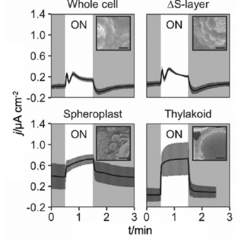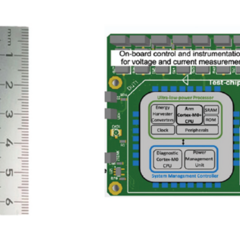Production of electricity from photosynthetic microorganisms
Production of electricity from photosynthetic microorganisms
We and others showed over 10 years ago that cyanobacteria (bacteria capable of oxygen-producing photosynthesis) produce small amounts of extracellular electric current, which increases on illumination (McCormick et al. (2011) Energy & Environmental Science https://doi.org/10.1039/C1EE01965A). This remarkable observation raises many questions:
Why do cells do it?
How does current get out?
Can we use it for renewable energy production?
We are trying to answer all these questions. It is possible that electron export is used as a ‘safety valve’ if cells absorb too much light energy. This can cause over-activity of the photosynthetic electron transfer chain and damage the cell. We know little about how current gets out, but use studies with mutants, subcellular preparations, and genetically modified cells using ‘state-of-the-art’ electrochemistry to look at this. We work closely with colleagues in the Cambridge Chemistry Department, especially Dr Jenny Zhang and Prof Tuomas Knowles, in this.
Figure 1: The graphs show how the current exported from cyanobacterial cells changes with time on illumination. Cells lacking an external layer (the S layer) show the same profile as wild type cells, but cells with peptidoglycan removed, and isolated thylakoids, show a different profile. This indicates that components in the periplasmic space ‘gate’ the export of current. Figure from Wey et al. (2021) Electrochimica Acta doi.org/10.1016/j.electacta.2021.139214.We have been able to use current from cyanobacteria to drive microprocessors, of the kind used in the Internet of Things. This shows that real-world applications are possible. We are particularly interested in using these systems for power generation in isolated areas of low-income countries, where small amounts of power can make a big difference. The systems might also be a literally green alternative to batteries for devices that need small amounts of power that cannot readily by connected to a power supply.
Figure 2: A device containing cyanobacteria that generated enough power to drive a small microprocessor (from ARM Computing) successfully for over a year. Images from Bombelli et al. (2022) Energy & Environmental Science doi.org/10.1039/D2EE00233G)We can also make similar devices using plants. See https://www.bbc.co.uk/news/uk-england-london-50056665 for our collaboration with scientists at London Zoo, using power generated from a plant to take a photo of the plant – the world’s first plant selfie!!
More information:
“A biophotoelectrochemical approach to unravelling the role of cyanobacterial cell structures in exoelectrogenesis” Wey LT, Lawrence JM, Chen X, Clark R, Lea-Smith DJ, Zhang JZ, Howe CJ. (2021) Electrochimica Acta 395:139214 doi.org/10.1016/j.electacta.2021.139214
“Powering a Microprocessor by Photosynthesis” Bombelli P, Savanth A, Scarampi A, Rowden SJL, Green DH, Erbe A, Årstøl E, Jevremovic I, Hohmann-Marriott MF, Trasatti P, Ozer E, Howe CJ (2022) Energy & Environmental Science 15:2529-2536. https://doi.org/10.1039/D2EE00233G


